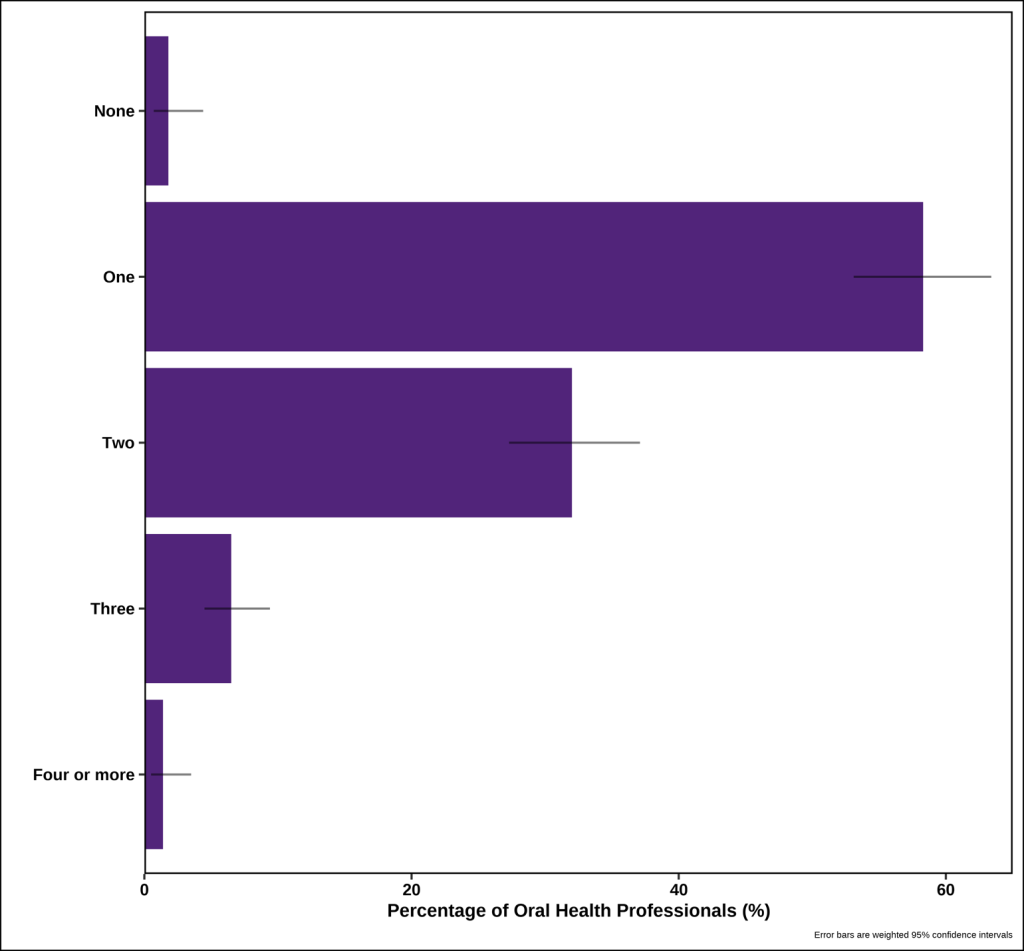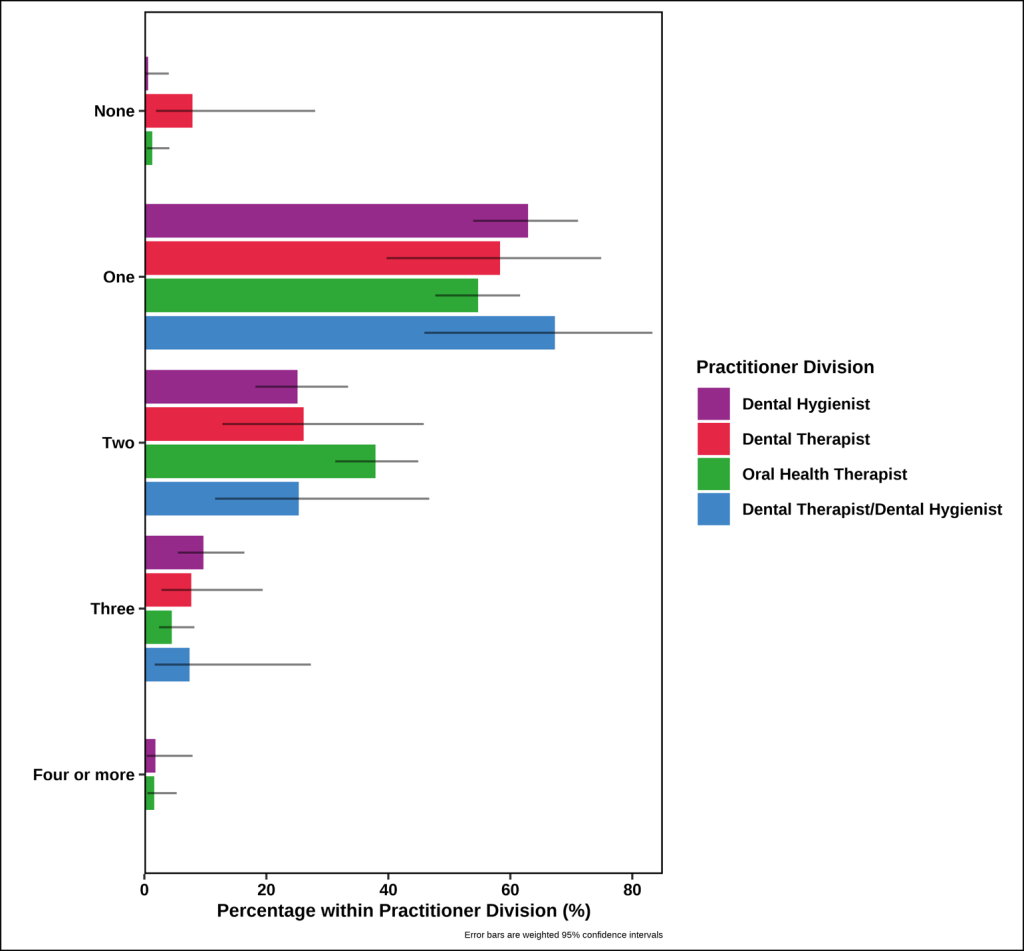6 Number of concurrent jobs
William Carlson-Jones and Jennifer Gray
Key Takeaways
This chapter reports the number of concurrent jobs held by profession in the oral health workforce.
Number of jobs
Figure 6.1 displays the weighted number of jobs concurrently held by OHPs. Over half (58.3%) of OHPs held just one job in the oral health workforce. Nearly one-third (32.0%) of OHPs held two concurrent jobs, while a smaller percentage held three concurrent jobs (6.5%). A small percentage of the workforce reported not holding employment in the FY 2021/2022 (1.8%) and a smaller percentage reported holding four or more jobs (1.4%).
Figure 6.1. Weighted number of jobs concurrently held.
Number of jobs by division
Figure 6.2. presents the weighted number of jobs concurrently held by OHPs by division. Over half of DTs held one job (58.3%) and approximately a quarter held two jobs concurrently (26.1%). A smaller proportion of DTs were reported to hold three jobs concurrently (7.7%). Nearly two-thirds of DHs held one job (62.9%) and a quarter held two jobs concurrently (25.1%). Approximately ten percent of DHs were reported to hold three jobs concurrently (9.7%).
More than half of the OHTs held one job (54.7%), while over a third held two jobs concurrently (37.9%). A small percentage of OHTs were reported to hold three jobs concurrently (4.5%) and four or more jobs concurrently (1.6%). Among dual-qualified DT/DHs, over two-thirds held one job (67.3%), about a quarter held two jobs concurrently (25.3%), and a small percentage held three jobs concurrently (7.4%). Less than a tenth of DTs (7.9%) reported that they did not hold any jobs, and only a small percentage of OHTs (1.3%) and DHs (0.6%)
Figure 6.2. Weighted number of jobs concurrently held by division.
Interpretation
The number of concurrent jobs held by OHPs varied across divisions, reflecting notable trends in the workforce. Most OHPs held one job, highlighting that the majority of the workforce maintained stable employment in a single role. Additionally, the low unemployment rate across the divisions suggests a strong demand for OHPs in the workforce, with limited numbers reporting no employment.
Variations in job-holding patterns were evident among different registration divisions. DTs exhibited a higher rate of unemployment compared to other divisions, which may reflect the older age profile of this workforce and a possible trend toward retirement. This aligns with broader workforce patterns where older practitioners begin transitioning out of clinical roles as they approach retirement age (Australian Institute of Health and Welfare, 2011).
Almost half of OHTs reported holding two or more jobs concurrently. This suggests OHTs, particularly those in early to mid-career stages, are seeking opportunities to practice across various settings in order to fully utilise their broad scope of practice. By working in multiple roles, these practitioners can gain experience in different areas of oral health therapy, which may be necessary for developing a more comprehensive skill set (Teusner et al 2016; Chen et al 2022).
A small proportion of OHTs and DHs held four or more concurrent jobs, which may be indicative of younger professionals exploring different career paths or balancing clinical and non-clinical roles simultaneously. This pattern could reflect a desire to diversify their professional experiences, potentially engaging in roles such as education, research, or management alongside clinical practice. This trend is consistent with literature indicating that younger professionals often explore various career pathways before settling into long-term roles (Chen et al. 2022).
These findings underscore the importance of providing diverse career pathways and opportunities for career development within the oral health workforce. As younger practitioners seek to expand their scope and explore non-clinical avenues, ensuring the availability of varied roles and adequate professional development opportunities is crucial for workforce retention and satisfaction. Further research into the motivations behind holding multiple jobs and the long-term career progression of OHPs could provide valuable insights for workforce planning and policy development aimed at sustaining a robust and adaptable oral health workforce.
Sources
- Australian Institute of Health and Welfare. 2011. Oral health practitioner labour force projections 2006–2025. Research report series no. 52. Cat. no. DEN 209. Canberra: AIHW.
- Chen D, Holden A & Hayes M. 2022. ‘Exploring the career experiences of Australian oral health therapists in different practice settings’, Community Dental Health, vol. 39, no. 1, pp. 99-105.
- Chen D, Hayes M & Holden A. 2022. ‘Investigation into the enablers and barriers of career satisfaction among Australian oral health therapists’, Community Dentistry and Oral Epidemiology, vol. 51, no. 1, pp. 301–310.
- Teusner DN, Amarasena N, Satur J, Chrisopoulos S, Brennan D. 2016. Applied scope of practice of oral health therapists, dental hygienists and dental therapists. Australian Dental Journal. 61: 342-349.
Oral health practitioner
Dental Therapists
Dental Hygienists
Oral Health Therapists



